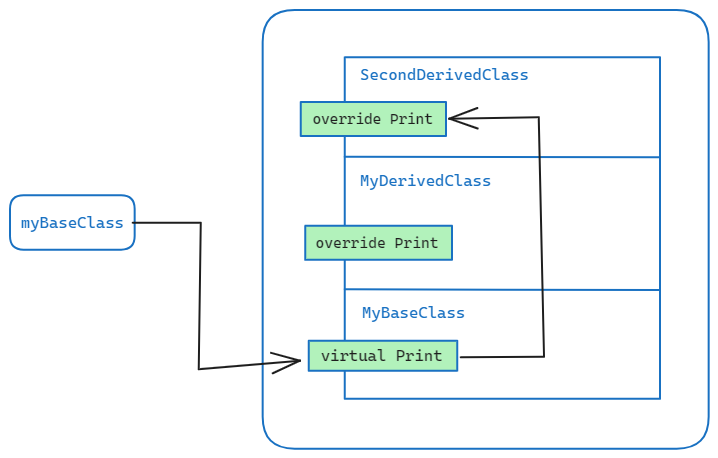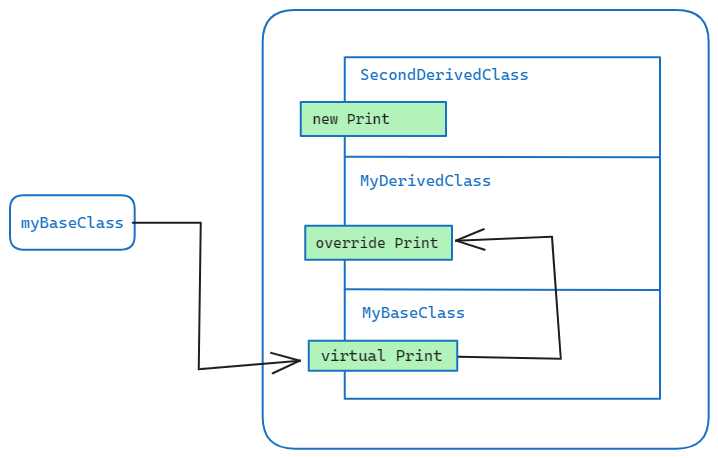?公众号「DotNet学习交流」,分享学习DotNet的点滴。
使用基类中的引用
class MyBaseClass //基类
{
public void Print()
{
Console.WriteLine("This is the base class");
}
}
class MyDerivedClass : MyBaseClass //派生类
{
new public void Print()
{
Console.WriteLine("This is the derived class");
}
}
internal class Program
{
static void Main(string[] args)
{
MyDerivedClass myDerived = new MyDerivedClass();
MyBaseClass myBaseClass = (MyBaseClass)myDerived; //转换成基类
myDerived.Print(); //从派生类部分调用Print方法
myBaseClass.Print(); //从基类部分调用Print方法
}
}
运行结果如下:

可以发现派生类调用的是派生类的方法,而基类调用的是基类的方法。
虚方法和覆写方法
虚方法可以使基类的引用访问“升至”派生类内,可以使基类引用调用派生类(derived class)的方法,只需满足下面的条件。
1、派生类的方法和基类的方法有相同的签名和返回类型。
2、基类的方法使用virtual标注。
3、派生类的方法使用override标注。
使用virtual和override的例子如下:
class MyBaseClass //基类
{
virtual public void Print()
{
Console.WriteLine("This is the base class");
}
}
class MyDerivedClass : MyBaseClass //派生类
{
override public void Print()
{
Console.WriteLine("This is the derived class");
}
}
class SecondDerivedClass : MyDerivedClass //派生类
{
override public void Print()
{
Console.WriteLine("This is the second derived class");
}
}
internal class Program
{
static void Main(string[] args)
{
SecondDerivedClass myDerived = new SecondDerivedClass();
MyBaseClass myBaseClass = (MyBaseClass)myDerived; //转换成基类
myDerived.Print(); //从派生类部分调用Print方法
myBaseClass.Print(); //从基类部分调用Print方法
}
}
运行结果如下所示:

不论是通过派生类调用还是通过基类调用,都会调用最高派生类中的方法,当通过基类调用时,调用被沿着继承层次向上传递,如下图所示:

SecondDerivedClass中的Print方法声明为override,它会覆写方法中的全部两个低派生级别的版本。
如果将SecondDerivedClass中的Print方法声明为new,代码如下所示:
class MyBaseClass //基类
{
virtual public void Print()
{
Console.WriteLine("This is the base class");
}
}
class MyDerivedClass : MyBaseClass //派生类
{
override public void Print()
{
Console.WriteLine("This is the derived class");
}
}
class SecondDerivedClass : MyDerivedClass //派生类
{
new public void Print()
{
Console.WriteLine("This is the second derived class");
}
}
internal class Program
{
static void Main(string[] args)
{
SecondDerivedClass myDerived = new SecondDerivedClass();
MyBaseClass myBaseClass = (MyBaseClass)myDerived; //转换成基类
myDerived.Print(); //从派生类部分调用Print方法
myBaseClass.Print(); //从基类部分调用Print方法
}
}
运行结果如下所示:

当Print方法通过SecondDerivedClass的引用调用时,SecondDerivedClass中的方法被执行,而当方法通过MyBaseClass的引用调用时,方法调用只向上传递了一级,到达类MyDerivedClass,在那里被执行。该过程的图示如下所示:

覆盖其他成员类型
其实属性事件以及索引器也是一样。
只读属性使用virtual/override的例子
代码如下:
class MyBaseClass //基类
{
private int _myInt = 5;
virtual public int MyProperty
{
get { return _myInt; }
}
}
class MyDerivedClass : MyBaseClass //派生类
{
private int _myInt = 10;
override public int MyProperty
{
get { return _myInt; }
}
}
internal class Program
{
static void Main(string[] args)
{
MyDerivedClass myDerived = new MyDerivedClass();
MyBaseClass myBaseClass = (MyBaseClass)myDerived; //转换成基类
Console.WriteLine(myDerived.MyProperty);
Console.WriteLine(myBaseClass.MyProperty);
}
}
运行结果如下所示:
